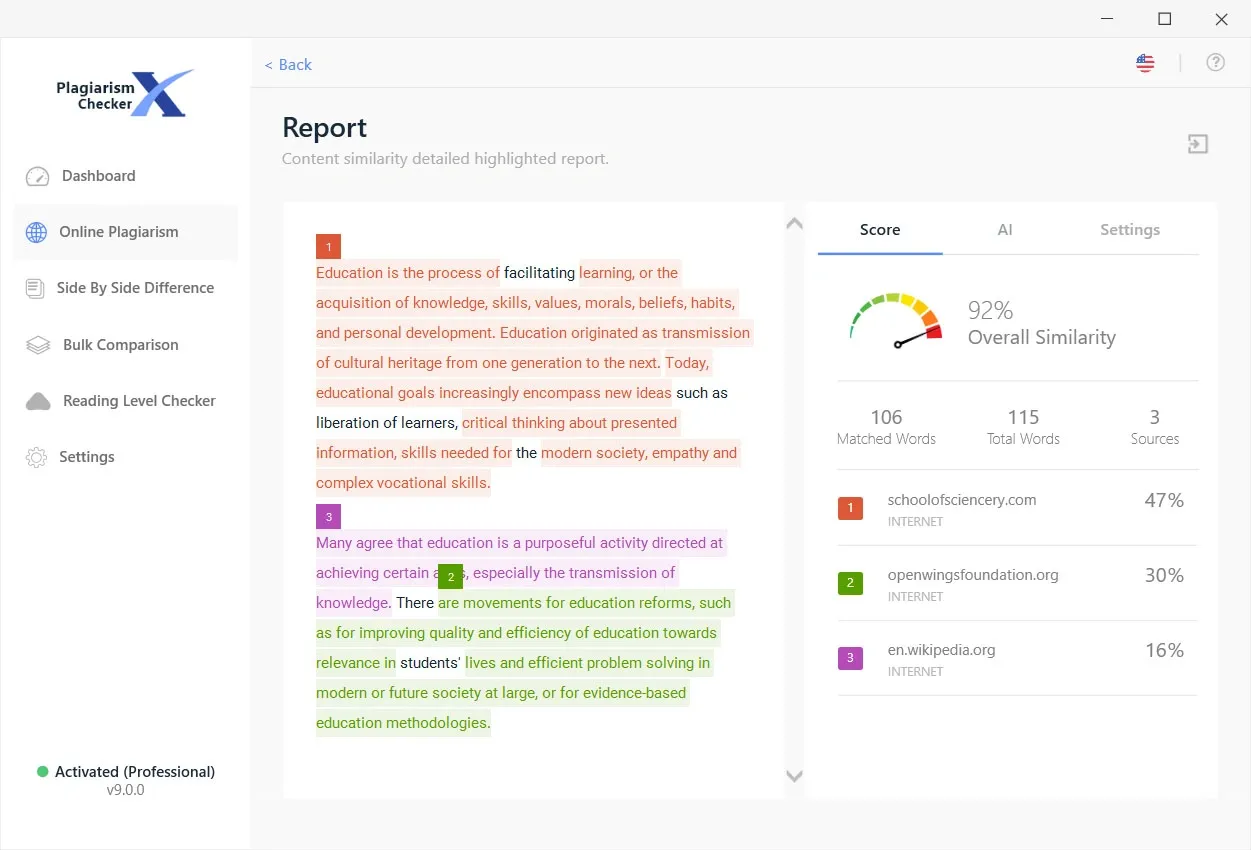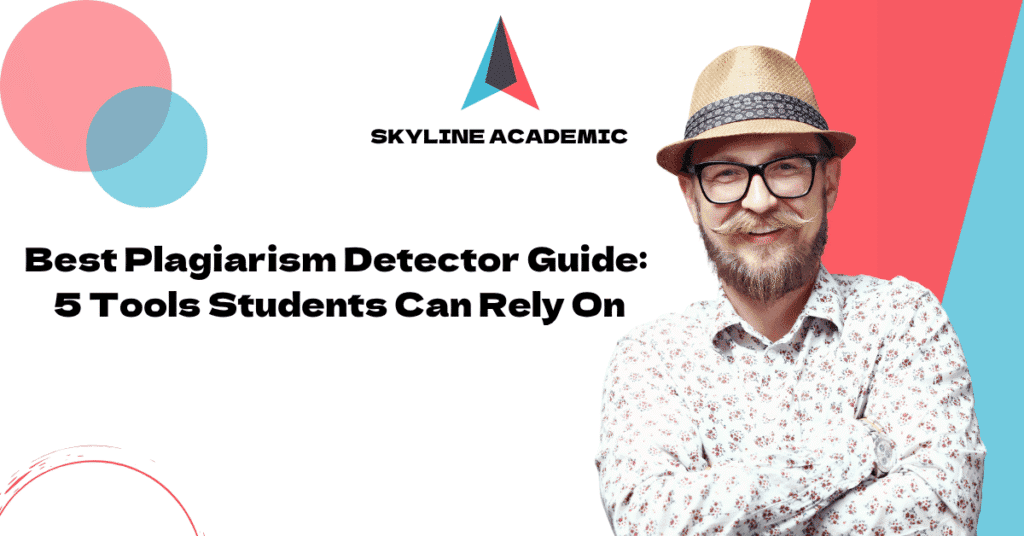Best Plagiarism Detector Guide: 5 Tools Students Can Rely On
Did you know plagiarism can get you kicked out of class and your degree taken away?
A good plagiarism detector isn’t just helpful—it’s vital to your success in school. Your academic work needs proper citations to be meaningful and credible. This helps you avoid the collateral damage that comes with accidental copying. The problems are systemic online, where many writers cut corners by using content without giving credit.
A clear understanding of what you’re protecting yourself against is significant to find the best plagiarism detector. Plagiarism breaks academic integrity rules when you use other people’s work without credit. Tools like Originality.AI can spot AI-written content with up to 94% accuracy. This helps keep your papers original. On top of that, Skyline Academic really analyzes your documents against big databases to make sure your work stays authentic with proper citations.
Plagiarism hurts more than your grades—it leads to academic penalties, legal troubles, and damages your reputation. Of course, learning to spot copied content in your papers will help you throughout school and beyond. This piece explores the best plagiarism detector and ways to check your work before you turn it in.
Understanding Plagiarism and Its Risks

Image Source: Affordable Colleges Online
Plagiarism is way beyond the reach and influence of copying someone else’s work. Students who want to maintain their academic integrity need to learn about what makes up this academic offense.
What counts as plagiarism?
You commit plagiarism when you present someone else’s work, ideas, or intellectual property as your own without proper attribution. This rule applies to text, images, audio, video, and PowerPoint presentations. The scope extends beyond published materials—using unpublished work without acknowledgment breaks the rules too.
Merriam-Webster Dictionary defines plagiarism as “to steal and pass off the ideas or words of another as one’s own” and “to commit literary theft”. A student who changes a few words or alters sentence structure without citing the source still commits plagiarism.
Types of plagiarism students often miss
Students often commit plagiarism without knowing it:
- Accidental plagiarism: This happens when you forget to cite sources, misquote them, or paraphrase without attribution. The consequences match those of thought-out plagiarism, even when unintended.
- Self-plagiarism: You can’t submit your previous work for a new assignment without permission. Using parts of your high school paper in a college assignment counts as plagiarism.
- Mosaic plagiarism: Taking phrases from different sources without quotation marks, or using synonyms while keeping the same structure. This “patch writing” breaks academic rules even with a footnote.
Consequences of plagiarism in school and beyond
Plagiarism’s impact reaches beyond a single assignment. Academic institutions might respond with failing grades, course failure, academic probation, or expulsion. Yes, it is common for schools to have academic integrity committees that watch over students.
Career prospects can crumble because of plagiarism. Business professionals, politicians, or public figures who get caught might lose their jobs and struggle to find new positions. Many professionals had to step down from prestigious roles after plagiarism came to light.
Skyline Academic’s plagiarism detection system gives you a full picture of your documents against extensive databases. This helps you avoid serious problems. The system spots subtle forms of plagiarism that students usually miss, like mosaic plagiarism and incorrect paraphrasing.
How to Avoid Plagiarism Before You Write
You should start preventing plagiarism well before submitting your paper to a plagiarism detector. Your research phase needs proactive steps to avoid academic honesty problems down the road.
Keep track of your sources
Good organization of research materials helps you avoid accidental plagiarism. You should save sources immediately by downloading PDFs or emailing articles to yourself as you gather information. Each source needs complete bibliographic information including author, title, publication details, and page numbers.
A master document works well to store quotes with their corresponding page numbers. Your notes become clearer when you highlight or color-code different authors’ ideas to separate them from your own thoughts. Citation information should always stay with the content in your notes—this simple habit helps you track where information came from.
Use citation tools from the start
Citation management software makes the research process easier. These tools help you collect, organize, and format references in various citation styles.
Popular options include:
- Zotero: A free tool that spots research as you browse and creates citations for articles, books, and websites
- EndNote: Helps you search resources, store references, and create accurate citations
- Mendeley: Lets you annotate and highlight source material directly in the interface
Skyline Academic’s plagiarism detection system blends with these citation tools to help maintain academic honesty throughout your writing process.
Paraphrasing without losing meaning
Good paraphrasing needs more than just word changes. Your paraphrasing will work better if you:
- Read the original passage until you understand it fully
- Put the original aside and write your version without looking at it
- Compare your version with the original and fix any parts that match too closely
- Add proper citations even for paraphrased content
Note that using synonyms or rearranging sentences isn’t enough—the best plagiarism detector software often flags this as “mosaic plagiarism”. You should understand the idea completely, then express it in your own way. Skyline Academic’s tools help you catch potential paraphrasing problems early in your writing process.
Top 7 Plagiarism Detectors for Students

Image Source: Plagiarism Checker X
Your choice of plagiarism detection tool can make a huge difference in protecting your academic integrity. Here are the seven best plagiarism detectors students can use:
1. Grammarly
This popular tool has a plagiarism checker along with grammar and spelling corrections. Grammarly scans your text against 16 billion web pages and gives you an originality score by highlighting potential matches. Tests show it detected only 3% of internet-plagiarized content, which makes it better suited for simple checks rather than detailed analysis.
2. Quetext
Quetext’s DeepSearch™ technology analyzes your writing against billions of internet sources. The ColorGrade™ feature shows exact and near-exact matches with corresponding colors so you can spot potential problems quickly. You can check 500 words with the free version, while paid plans start at $8.80 monthly.
3. Turnitin
Educational institutions rely heavily on Turnitin, and colleges that use it saw unoriginal writing drop by 39%. The platform compares student papers with a massive database of academic and web content. Its AI detection capabilities show varying accuracy rates.
4. Scribbr
Scribbr runs your work against 99 billion web pages and 8 million publications. The plagiarism checker excels at finding even heavily edited texts. Unlike many other tools, Scribbr doesn’t store your documents in searchable databases.
5. Originality.AI
This tool stands out by detecting both plagiarism and AI-generated content accurately. Tests reveal it performs better than competitors when identifying paraphrased plagiarism at both 5% and 15% thresholds.
6. Skyline Academic
Skyline Academic provides one of the most thorough plagiarism detection systems today. Their technology protects against content duplication while analyzing AI-generated text. The system finds subtle forms of plagiarism that students often overlook.
You need a reliable plagiarism detector? Skyline Academic provides advanced plagiarism detection technology built specifically for students and educators. Their detailed reports help you spot potential issues before you submit your work.
7. Copyscape
Leading companies worldwide have trusted Copyscape for over twenty years. The tool works great to check if AI-generated text has content directly copied from the internet.
What to Do If Your Paper Shows Plagiarism
Plagiarism in your paper doesn’t mean academic failure—if you know how to handle it right. A plagiarism report can shake you up, but knowing how to read and fix the issues can protect your academic standing.
Reviewing the report carefully
The similarity score shows how much of your text matches other sources. The color coding (blue through red) shows different similarity ranges—blue means no matches while red shows 75-100% matching text.
Your overall percentage doesn’t tell the whole story, and a high score doesn’t automatically mean plagiarism. A paper with proper quotes and a big bibliography might show 53% similarity while following all academic rules. Each highlighted section needs individual attention to understand what kind of match you’re dealing with.
Don’t worry if your name shows up highlighted—this happens because it matches your previous work. Multiple draft submissions can also lead to higher scores that don’t really mean anything.
How to rewrite or cite properly
Direct quotes in your report need quotation marks and proper citations with page numbers. When you paraphrase, you need to rewrite the idea completely in your own words but still give credit.
Here’s how to fix plagiarism:
- Read the original text until you get it completely
- Write your version without looking at the source
- Check your version against the original and fix any parts that match too closely
The key is to rewrite whole paragraphs instead of just swapping words—this keeps the meaning while making it your own.
When to ask for help from your instructor
Your instructor would rather hear from you before submission than find plagiarism issues later. The fallout from plagiarism hits harder than a late submission, so asking for help early shows you care about doing things right.
Skyline Academic’s plagiarism detection tool can help you spot problems early if you’re worried about plagiarism. Their reports make it clear exactly what needs fixing before you submit.
Many schools now take a learning-focused approach instead of just punishing plagiarism. Students get a chance to learn about academic integrity and rebuild trust with their instructors.
Conclusion
Your academic reputation depends on how well you understand and prevent plagiarism. You now have what you need to check your papers before submission. Academic integrity needs both awareness and action – you must know what counts as plagiarism and use good detection tools.
Plagiarism can affect way beyond a single assignment. It might derail your academic or professional career completely. Time spent on proper citations and tracking sources will pay off throughout your academic trip. Skyline Academic gives complete protection against regular plagiarism and AI-generated content that could affect your work’s originality.
Start tracking sources and using proper citation right from the beginning of your research. Become skilled at paraphrasing to keep your ideas authentic while building on existing knowledge. The sort of thing I love about good paraphrasing is that it needs you to really understand the original content, not just swap words around.
Good plagiarism detectors do more than show similarity scores – they give detailed reports to help spot potential issues. Skyline Academic catches subtle forms of plagiarism that students often miss, like mosaic plagiarism and poor paraphrasing. This helps you fix problems before submission instead of facing serious consequences later.
Academic integrity is the foundation of your educational credibility. Finding plagiarism in your paper might worry you, but you can fix these issues with proper citations or careful rewriting. Skyline Academic’s system analyzes your documents against huge databases to keep your work original and properly credited.
Good research habits and the right tools determine your academic success. By doing this and being organized with reliable plagiarism detection software like Skyline Academic, you protect your reputation while creating original work. These skills will help you long after graduation, building lifelong habits of honest writing and proper attribution.
FAQs
Q1. What are some reliable plagiarism checkers for students? Some of the best plagiarism detectors for students include Grammarly, Quetext, Turnitin, Scribbr, Originality.AI, Skyline Academic, and Copyscape. Each offers unique features, with Skyline Academic providing comprehensive plagiarism and AI-generated content detection.
Q2. How can I avoid plagiarism in my academic writing? To avoid plagiarism, keep track of your sources, use citation tools from the start, and practice proper paraphrasing. When paraphrasing, read the original text thoroughly, write your version without looking at it, then compare and edit as needed. Always cite your sources, even when paraphrasing.
Q3. What constitutes plagiarism in academic work? Plagiarism includes presenting someone else’s work, ideas, or intellectual property as your own without proper attribution. This applies to text, images, audio, video, and even unpublished work. Changing a few words or altering sentence structure without citation is also considered plagiarism.
Q4. What should I do if my paper shows signs of plagiarism? If your paper shows plagiarism, carefully review the similarity report. For direct quotes, ensure proper citation. For paraphrased content, rewrite substantially in your own words while still providing attribution. If unsure, seek guidance from your instructor before submission.
Q5. What are the consequences of plagiarism in academic settings? The consequences of plagiarism can be severe, ranging from failing an assignment to course failure, academic probation, or even expulsion. Beyond academia, plagiarism can damage your professional reputation and career prospects. It’s crucial to maintain academic integrity throughout your educational journey.


![Is Cyber Security Hard Expert Guidance Makes It Easy [2025]](https://skylineacademic.com/wp-content/uploads/2025/10/is-cyber-security-hard-expert-guidance-makes-it-easy.png)
